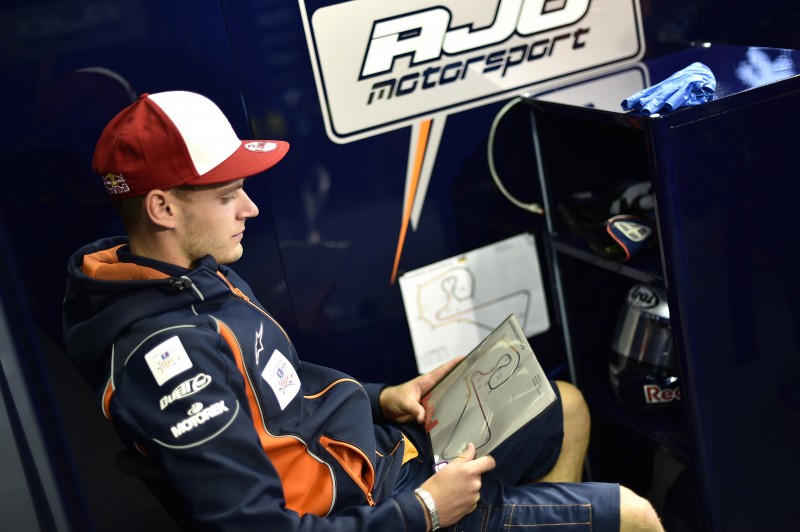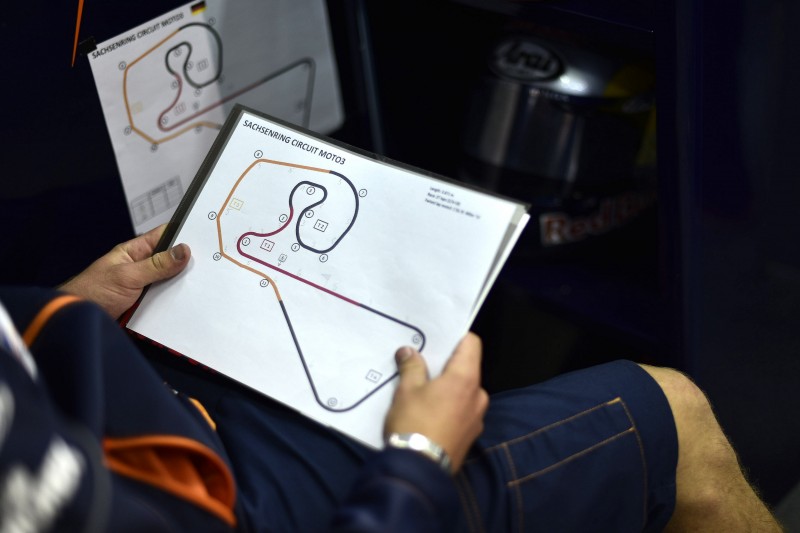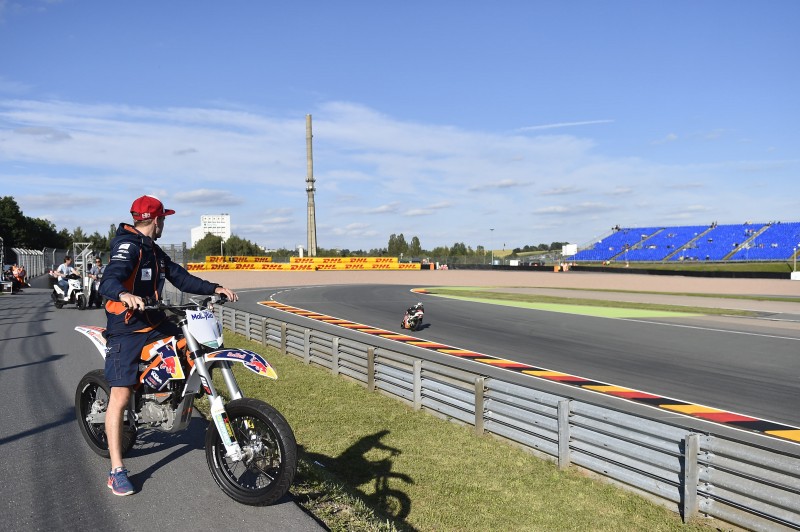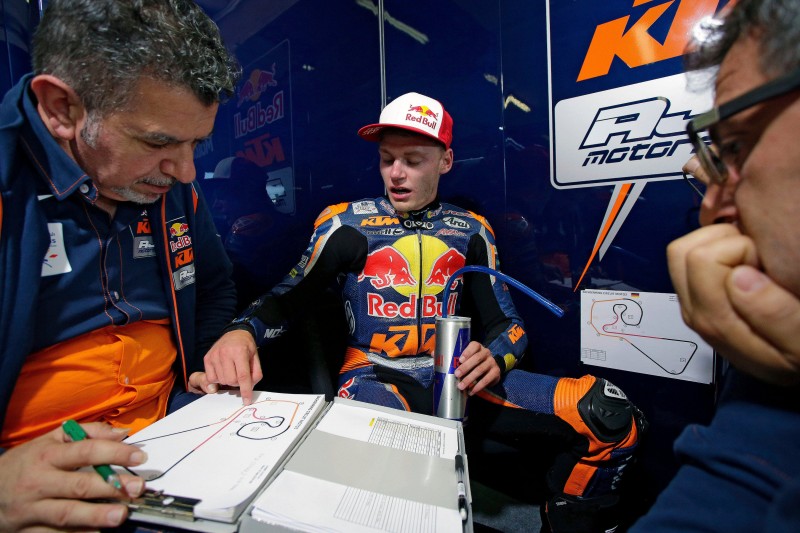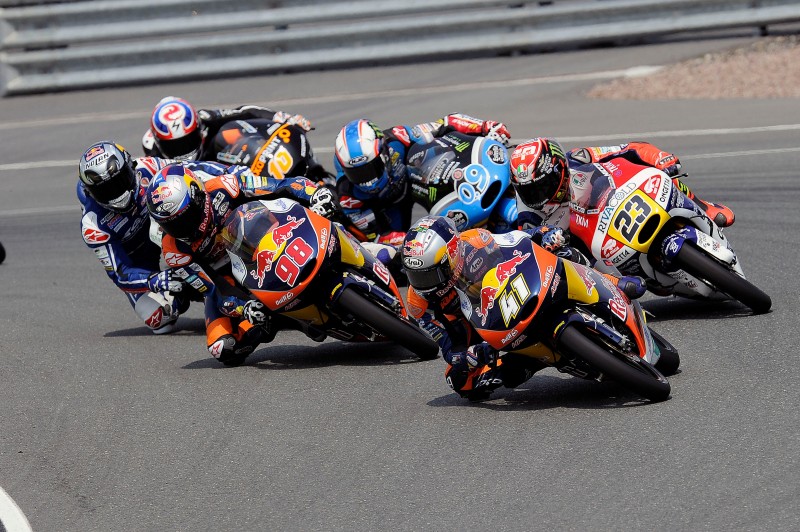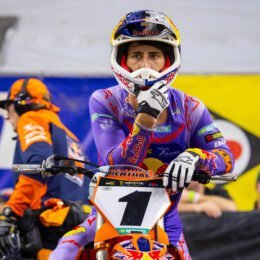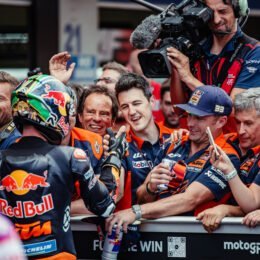Finding the line
When a Motorcycle World Championship rider comes to a new race course that was previously unknown to them, this is a delicate ride of discovery. Brad Binder from the Red Bull KTM Ajo Moto3 Team describes how he manages this task.
Sachsenring, the German Motorcycle Grand Prix, Thursday afternoon, the engines are still silent. Brad Binder is sitting in the Ajo Team box and thinking about an answer to the question as to which Grand Prix circuit was the most difficult for him to learn.
“Maybe Silverstone”, he says. “Because there are so many turns to learn there.” He casts a questioning glance over to teammate Karel Hanika, who has sat down next to him. Hanika has a different suggestion: Malaysia. “Yeah, right!”, Binder calls. “Malaysia was tough.”
Then Binder tells me all about his first ride on this circuit near Kuala Lumpur in 2011 – and how he lost eight seconds on the lead time in the first training session. Eight seconds. Ages. Things got a little better in each training session; in the race, two days later, Binder was still more than three seconds down on the best lap times. Binder had had enough, initially. What makes Malaysia so difficult? “It is the enormous width of this circuit. It is really difficult to find the right line there.” He finds narrower circuits easier to learn. Assen, for example.
Motorcycle World Championship riders and their orientation problems when they come to a new race course: Everyone has their own story to tell. But how do GP pilots approach a new circuit? How do they prepare? The first thing is: to sit down and do your homework. “I watch videos of earlier races,” says Binder. This shows him, for example, that his colleagues braked at the 100-meter mark before turn 5. Early indicators, first hints. And then Binder sits down at his gaming console. MotoGP on PlayStation – essential. In 2012, his first full World Championship season, as Binder relates, he often turned to his PlayStation.
When Binder arrives at the circuit on the Wednesday before a Grand Prix, the first item on the list is studying the telemetry data. Braking points, braking intensity, gears: everything that was logged by data recording for his teammates is analyzed.
The next day, Thursday, this is followed by exploring the track. But not on foot. Binder prefers a scooter. It is only at overseas races, to which the Moto3 team does not usually take its scooters, that Binder is forced to walk. Binder works his way from turn to turn. He notes that he should avoid the curbs at the hairpin, because they are high. And that the finishing turn closes in, that is, it becomes tighter at the exit. He stores all of these impressions on the hard disc in his head, so that he can retrieve them again later on his Moto3 KTM.
Friday morning, the first training session, the moment of truth. After videos, PlayStation, data analysis and exploring the track, it is now time to test the theory against the facts. Binder says that the first two or three rounds show whether all the theoretical findings from up front are confirmed. Or if you maybe could get away with cutting the curb in the hairpin.
A Motorcycle World Championship rider typically experiments with the suspension setting during the first free practice sessions. But on a new circuit, on which the rider initially loses seconds per lap, playing around with damper settings and other subtleties is unnecessary. Until the rider gets close to pushing the limits, setup work makes no sense at all. But the learning curve has to be complete no later than the second training session on the Friday, says Brad Binder. After that, the focus has to shift to finding the perfect setup. What he does not say: colleagues who already know the course then have a significant know-how advantage when it comes to the setup.
He learns new circuits quickly, Binder believes. This was a consequence of the fact that all European circuits were new to him as a South African. That was excellent schooling. Brad’s younger brother Darryn, who is also racing in the Moto3 World Championship this year, now faces the same challenge: many circuits are new territory. Does his older brother help him?
“I give Darryn all the circuit data. And we explore the race course together on scooters.” But does he let his brother tail him in free training so that he can learn the line? Or wait for him in qualifying so that Darryn can ride in his slipstream? No. “As a KTM factory rider, I have to look out for number one. I can’t play instructor for Darryn during training.”
And then Brad Binder walks down the steps of the Ajo team truck; his gaze falls on the right-hand bend behind the pit lane exit. That brings back memories. “My first race here at Sachsenring … oh dear.” He laughs. Why oh dear? Binder tells me that, back then in the Red Bull MotoGP Rookies Cup, it was not just the track, but also the rain that was new for him. In his native South Africa, motorcycle races are not started in the rain. In other words, Sachsenring 2009 was Brad Binder’s first outing on a race bike in the rain. At first, he had wondered why the others were riding so slowly. In round 4 he found out: after a highside, he ended up lying on the track with a broken finger.
Photos: Marco Campelli


